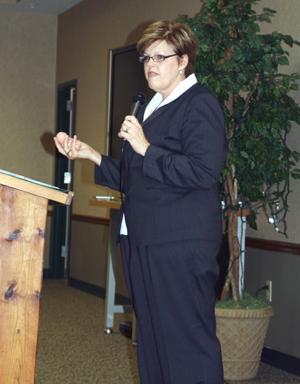
By Anne Marie Amacher
DAVENPORT — After witnessing a traffic accident and being unable to help one of the victims, a child who died, Jill Stanek decided to become a nurse so she could help others.
But while working in the labor and delivery unit of a hospital, she said she was dealt two blows. The first was finding out late-term abortions were being performed. The second was learning that some babies were born alive and left to die without medical intervention.
She became aware of these facts some time after starting work at Christ Hospital, which is south of Chicago and is sponsored by the Evangelical Lutheran Church in America and United Church of Christ. “Who would have thought a hospital with the name Christ would perform abortions?” she asked an audience of nearly 135 people who gathered Oct. 29 at the Center for Active Seniors Inc. (CASI) in Davenport to hear her speak. The event was sponsored by Quad-City Right to Life.
Stanek said she was on duty when a coworker took a 21-week-old fetus with Down syndrome who had been aborted, but born alive, and placed him in the soil/utility room to die. The other nurse did not want to hold the baby until he died. “I held him for 45 minutes until he died,” Stanek said.
Stanek showed a video clip from an interview she did on the “O’Reilly Factor” on FOX TV News in 2000. The host, Bill O’Reilly, asked Stanek if the babies were allowed to starve to death. “They probably don’t live long enough to starve,” she said. Their lungs are not mature, she told him.
The abortions were performed when a physician or resident inserted a pill into a pregnant woman’s cervix to open it up. “The second- or third-trimester baby ‘falls out,’” she told O’Reilly. After that, if the baby was born alive, he or she was wrapped in a blanket and held by a staff member if the family did not want to hold the baby until the baby died.
Aborted babies who are born alive typically live one-and-a-half to three hours, she noted. “One was alive for eight hours.”
Stanek told her audience in Davenport she was unaware during her 12-week orientation and throughout the first year of working at the hospital that abortions were being performed.
She learned from coworkers that it was not all that uncommon for an aborted baby to be born alive. The death certificate would list “extreme prematurity” as cause of death.
Most of the abortions were performed because ultrasound images indicated an abnormality with the fetus, such as spinal bifida or Down syndrome.
“It was too much for me to bear. I decided I had to stay and fight — or leave.”
Stanek wrote a letter to religious leaders of the hospital. She was surprised to learn they knew of the abortions. Following that letter, Stanek’s supervisor met with her.
Hospital officials, she said, told her that what they were doing was the most “compassionate way of dying for the parents and for the baby.”
She then met with her own pastor of a Christian church. They contacted people such as C. Everett Koop, the former U.S. surgeon general, and Cardinal Francis George and Concerned Women for America, who all wrote letters to the hospital. There were no plans to stop the abortions.
In July 1999, Stanek’s pastor wrote to pastors in the Chicago area and “that triggered a public outcry.”
Newspapers and television stations across the nation picked up the story.
“I started getting calls from others that this was happening in their hospitals, too.”
Stanek continued to work at Christ Hospital and kept the abortion issue alive. During days off, she testified at the state and federal level about what she saw and had learned.
Two years after bringing the issue to light, Stanek was fired and escorted out of the hospital. “The next day I made the New York Times on Page 2.”
She continued testifying and highlighting the issue. In 2002, President George H.W. Bush signed the Infants Born Alive Act that states: “any baby that has been born alive is to be legally considered a person. As such, she or he would automatically be granted full protection under the U.S. Constitution. Other existing laws require that newborns must receive medical attention as needed. Killing a born-alive infant would be considered murder. …”
Stanek was present for the signing of both that bill and the Partial Birth Abortion Ban bill in 2003.
Although the Infants Born Alive Act is an important law, she said it has no real penalties and is hard to enforce. So babies continue to die.
Today, a fetus is considered viable at about 23 weeks gestation or if he/she weighs at least one pound. If a mother naturally goes into labor at that point, or an emergency delivery is required, steroids can be given to mature the infant’s lungs so the chance of survival is greater.
Stanek is encouraged by a Gallup poll from earlier this year that more Americans view themselves as pro-life versus pro-choice. “I think people are turning and more see abortion as murder.”
Following her talk, Stanek answered a variety of questions that addressed such things as what can be done by young people who are not old enough to vote and the use of graphic pictures to illustrate the horrors of abortion.
You can read her blog at www.jillstanek.com.
Lorrie Bowman, president of Quad-City Right to Life, said Stanek did a great job and told a “gripping story. I was amazed that she stayed at that hospital for two years. She showed courage and strength.”








